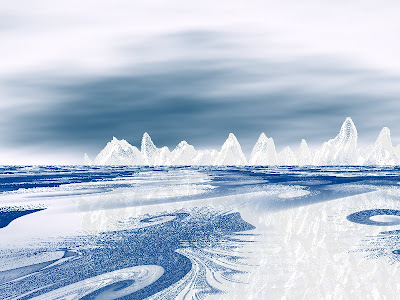Describing a devastated world

The excerpts on italic are a free montage describing the event known as the "1930´Dust Bowl". For us, living already the potential consequences of the global warming, is not difficult to understand the tragic colors of the Plains´s tragedy. For sure is possible to say that the causes of the global warming are different from what produced the Dust Bowl. That is right. But since we don´t have yet a clear panorama of the possible events in our future, we can learn something from our past to help us prevent our present :-)
The day was warm and pleasant, a gentle breeze whimpered out of the southwest. Suddenly a cloud appeared on the horizon. Birds flew swiftly ahead of it, but not swift enough for the cloud traveling at sixty miles per hour. This day, which many people of the area readily remember, was named "Black Sunday".
The clouds appeared on the horizons with a thunderous roar. Turbulent dust clouds rolled in generally from the North and dumped a fine silt over the land. Men, women and children stayed in their houses and tied handkerchiefs over their noses and mouths. When they dared to leave, they added goggles to protect their eyes. Houses were shut tight, cloth was wedged in the cracks of the doors and windows but still the fine silt forced its way into houses, schools and businesses. During the storms, the air indoors was "swept" with wet gunny sacks. Sponges were used as makeshift "dust masks" and damp sheets were tied over the beds.. The dust storm that turned day into night. Many believed the world was coming to an end.
A giant dust storm engulfs Boise City. Cyclic winds rolled up two miles high, stretched out a hundred miles and moved faster than 50 miles an hour. These storms destroyed vast areas of the Great Plains farmland. The methods of fighting the dust were as many and varied as were the means of finding a way to get something to eat and wear. Every possible crack was plugged, sheets were placed over windows and blankets were hung behind doors. Often the places were so tightly plugged against the dust (which still managed to get in) that the houses became extremely hot and stuffy.
The clouds appeared on the horizons with a thunderous roar. Turbulent dust clouds rolled in generally from the North and dumped a fine silt over the land. Men, women and children stayed in their houses and tied handkerchiefs over their noses and mouths. When they dared to leave, they added goggles to protect their eyes. Houses were shut tight, cloth was wedged in the cracks of the doors and windows but still the fine silt forced its way into houses, schools and businesses. During the storms, the air indoors was "swept" with wet gunny sacks. Sponges were used as makeshift "dust masks" and damp sheets were tied over the beds.. The dust storm that turned day into night. Many believed the world was coming to an end.
A giant dust storm engulfs Boise City. Cyclic winds rolled up two miles high, stretched out a hundred miles and moved faster than 50 miles an hour. These storms destroyed vast areas of the Great Plains farmland. The methods of fighting the dust were as many and varied as were the means of finding a way to get something to eat and wear. Every possible crack was plugged, sheets were placed over windows and blankets were hung behind doors. Often the places were so tightly plugged against the dust (which still managed to get in) that the houses became extremely hot and stuffy.
It seemed like the wind and dirt had been blowing for an eternity. Rain was an event occurring only in dreams. It was a year of intensive dirt storms, gales, rollers and floods mixed with economic depression, sickness and disaster. It was a year of extreme hardship, but surprisingly the vast majority of the people stayed. By 1935, the unusual had become the usual, the extreme became the normal, the exception became the routine.

If you like to read the full text of the Dust Bowl, go in here.

If you like to read the full text of the Dust Bowl, go in here.




3 Comments:
I experienced a dust storm twice during my six months living in Phoenix, Arizona. Of course, it only lasted for about an hour. It looked very much like the storm clouds in the photos you linked to. It's rather disturbing to see that big "boiling" thing moving your way when you don't know what it is.
If I'd lived in the 30's I'd probably have thought the world was coming to an end too. But no, it looks like the end of the world will be a drawn out process. Something like one of those 30-volume sets detailing the fall of some ancient empire.
2/04/2007 2:56 PM
I really love that first picture you posted! It is truly a thing of beauty.
2/05/2007 3:12 AM
Dzeni,
the second one is very same the first image - only under desolation and dust-suffocating. Both were created with reb.ucl Landscape and tma.ucl Painter´s Traps, on mt.ufm Vine.
Thank you for the appreciation.
2/05/2007 6:48 AM
Post a Comment
<< Home